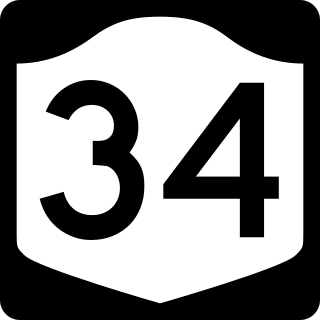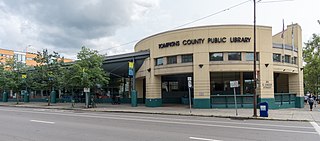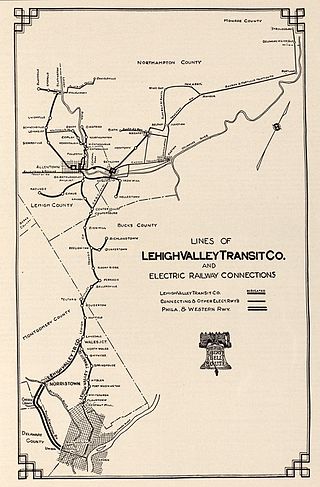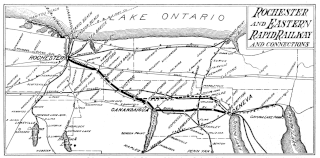
The New York, Auburn and Lansing Railroad, also known as the Ithaca-Auburn Short Line, was the only interurban line to operate in Tompkins County, New York.

The New York, Auburn and Lansing Railroad, also known as the Ithaca-Auburn Short Line, was the only interurban line to operate in Tompkins County, New York.

Promoted by Albert H. Flint, the New York, Auburn and Lansing Railroad was chartered on March 16, 1900. It was to re-use the old "Murdock Line", a rail grade which had briefly seen service as part of the Auburn Branch of the New York and Oswego Midland Railroad, to connect Ithaca and Auburn, and would enter Ithaca via a friendly connection with the Ithaca Street Railway.
The road was conceived of as a third-rail-powered interurban, but as the expense proved prohibitive, the line was only electrified between Ithaca and South Lansing, using overhead wire. Operations north of there were run by steam. The line used the Ithaca street railway's Tioga Street line from its terminus between State and Seneca streets in Ithaca to the north side of Percy Field (current site of Ithaca High School), then climbed out of the Lake Cayuga basin through Renwick and Twin Glens, parallel to and below the current New York State Route 13, and reached the Murdock Line grade at South Lansing. It followed the grade north through the hamlets of Genoa, Venice, Scipio and Mapleton. On the outskirts of Auburn, it swung east from the former Ithaca, Auburn and Western Railroad grade (which had built from the end of the Midland's Auburn Branch at Scipio to Genoa Jct., just west of Auburn) and reached a connection with the Lehigh Valley Railroad just within the city limits of Auburn. Construction began in 1906 from the Auburn end, and reached South Lansing on March 1, 1908. The line into Ithaca was opened on December 12, 1908.

Service between Ithaca and South Lansing was operated with streetcars leased from the Ithaca Street Railway. An interchange track with the Lehigh Valley was laid at Remington, near the base of the hill, but the steep grade and limited tractive capacity of the streetcars meant that business was minimal. Service from South Lansing to Auburn was steam-operated. In 1909, a 0.5-mile branch was built by Col. J.V. McIntyre, owner of the Rogues' Harbor Inn, from his establishment to South Lansing. This was also electrified, and regular service from Ithaca to Rogues' Harbor Inn was established.
Throughout its life, the Short Line (as it was known to residents) faced stiff competition from the Lehigh Valley's Ithaca & Auburn Branch. The two-car maximum up the hill out of Ithaca effectively guaranteed to the LV the freight business of Ithaca, but the Short Line offered four trains a day between Ithaca and Auburn, against two for the Lehigh Valley. However, the Short Line lacked the financial resources of the Lehigh Valley, and struggled in the harsh upstate winters. It went into receivership in 1912 and was reorganized as the Central New York Southern Railroad in 1914 (organized May 28; property of NYA&L conveyed July 14). At this time the initial grade out of Ithaca was eased somewhat with the construction of an S-shaped approach from Percy Field, replacing the use of the steeper Cayuga Heights loop of the Ithaca Street Railway; this is the abutment over East Shore Drive that is still in place. This gentler grade allowed the use of gas-powered McKeen cars through to Auburn, so that passengers no longer needed to change from electric to steam in South Lansing. The purchase of two McKeen cars to speed the Ithaca-Auburn run could not put off insolvency forever. However, because the City of Ithaca refused permission for the McKeen cars to run down Tioga Street, passengers from downtown Ithaca still had to transfer, now at a spur on the east side of Percy Field, just below the Lakeview Cemetery. The Rogues Harbor spur was closed on October 19, 1920, and the last run on the main line was made on October 19, 1923. The railroad was formally abandoned in 1924, and rail was removed in 1925, except for the line from Ithaca to Remington, which was operated by the Ithaca Traction Corporation to serve a powerhouse until 1931.

Much of the grade is still visible along the length of the route, though occasionally cleared for agriculture or new development in towns. In Ithaca, the roadbed is used for sewer access and maintenance, and has been proposed as the route of the East Shore Trail. In North Lansing, a fill constructed by the Short Line over Beardsley's Gulf (the valley of Locke Creek), replacing a 480-foot trestle of its predecessors, still remains.

Ithaca is a city and the county seat of Tompkins County, New York, United States. Situated on the southern shore of Cayuga Lake in the Finger Lakes region of New York, Ithaca is the largest community in the Ithaca metropolitan statistical area. It is named after the Greek island of Ithaca.
Danby is a town in Tompkins County, New York, United States. The population was 3,457 at the 2020 census. The town is in the southern part of the county and is south of the city of Ithaca.

The interurban is a type of electric railway, with tram-like electric self-propelled rail cars which run within and between cities or towns. The term "interurban" is usually used in North America, with other terms used outside it. They were very prevalent in North America between 1900 and 1925 and were used primarily for passenger travel between cities and their surrounding suburban and rural communities. The concept spread to countries such as Japan, the Netherlands, Switzerland, Belgium, Italy and Poland. Interurban as a term encompassed the companies, their infrastructure, their cars that ran on the rails, and their service. In the United States, the early 1900s interurban was a valuable economic institution, when most roads between towns, many town streets were unpaved, and transportation and haulage was by horse-drawn carriages and carts.
The Lehigh Valley Railroad was a railroad built in the Northeastern United States to haul anthracite coal from the Coal Region in Pennsylvania. The railroad was authorized on April 21, 1846, for freight and transportation of passengers, goods, wares, merchandise, and minerals in Pennsylvania and the railroad was incorporated and established on September 20, 1847, as the Delaware, Lehigh, Schuylkill and Susquehanna Railroad Company.

New York State Route 34 (NY 34) is a north–south New York state route located in Central New York. Its southern terminus is at the Pennsylvania state line in the village of Waverly, where it connects to Pennsylvania Route 199 and meets I-86/NY 17. Its northern terminus is at NY 104, outside the village of Hannibal.

Tompkins County Public Library (TCPL) is the public library for residents of Tompkins County, New York. The library has one branch which is located in Ithaca, New York.

The Finger Lakes Railway is a Class III railroad in the Finger Lakes region of New York. The company began operations on July 23, 1995, and operates in Onondaga, Cayuga, Seneca, Ontario, Schuyler and Yates counties. The FGLK operates 18 diesel locomotives on 167 miles (269 km) of ex-Conrail trackage, formerly owned by the New York Central Railroad, the Pennsylvania Railroad and the Lehigh Valley Railroad. Between 2001 and 2013, the railroad operated a heritage railroad known as the Finger Lakes Scenic Railway which offered passenger train excursions.
This is a list of trails in Ithaca, New York.

New York State Route 38 (NY 38) is a north–south state highway in the Finger Lakes region of New York in the United States. Its southern terminus is at an intersection with NY 96 in the town of Owego in Tioga County. The northern terminus is at a junction with NY 104A in the town of Sterling in Cayuga County. NY 38 is a two-lane local road for most of its length. The route is the main access road to parts of Auburn, Dryden, Newark Valley and Port Byron. It passes through mountainous terrain in Tioga and Cortland counties, but the terrain levels out as it heads through the Finger Lakes area and Cayuga County.

New York State Route 34B (NY 34B) is a north–south state highway located within Tompkins and Cayuga counties in Central New York in the United States. Its northern terminus is located at a junction with NY 34 by the hamlet of Fleming within the town of the same name in Cayuga County. The southern terminus is located at a junction with NY 38 in the town of Dryden in Tompkins County.
The Ithaca, Auburn and Western Railroad was a short-lived railroad connecting Ithaca and Auburn.
The Allentown Railroad was a railway company in the United States. It was incorporated in 1853 with the original intention to connect the Central Railroad of New Jersey at Allentown with the Pennsylvania Railroad's main line across the Allegheny Mountains. Though grading was almost entirely finished, the project was halted by the Panic of 1857, and the completion of the East Pennsylvania Railroad in 1859 made the Allentown Railroad's proposed line largely redundant. As a result, track was never laid on most of the line. The small portion that did became the Allentown branch of the Reading Company from Topton to Kutztown, and was nominally owned by the Allentown Railroad until the Reading dissolved it in 1945 to simplify corporate bookkeeping. Other Reading subsidiaries also laid track on parts of the right-of-way elsewhere along the route. The short line Allentown & Auburn Railroad continues to operate freight service on the Topton to Kutztown route.

The Lehigh Valley Transit Company (LVT) was a regional transport company that was headquartered in Allentown, Pennsylvania. The company began operations in 1901, as an urban trolley and interurban rail transport company. It operated successfully into the 1930s, but struggled financially during the Great Depression, and was saved from abandonment by a dramatic ridership increase during and following World War II.
Lansing is a town in Tompkins County, New York, United States. The population was 11,691 at the 2020 census.
The Auburn Trail is a multi-use rail trail located principally in the towns of Victor and Farmington, Ontario County, New York (USA). It is approximately 11 miles (18 km) long and maintained by the Towns of Victor and Farmington and Victor Hiking Trails. The trail mostly follows the alignment of the Auburn and Rochester Railroad. Additional disconnected portions of the Auburn trail are found in the Towns of Pittsford and Brighton, Monroe County, NY. A detailed description and map of the Auburn Trail are available from Victor Hiking Trails.

The Cayuga and Susquehanna Railroad was a railroad in the state of New York, in the United States. Its line ran from Ithaca, New York to Owego, New York. It was founded in 1829 and began operations in 1834. The Delaware, Lackawanna and Western Railroad (Lackawanna) leased the company in 1855, but it remained in existence as a non-operating subsidiary. It was conveyed to Conrail in the bankruptcy of the Erie Lackawanna Railway, successor to the Lackawanna, in 1976.

The Rochester and Eastern Rapid Railway (R&ER) was an electric interurban railway in New York State, USA, connecting Rochester, Canandaigua, and Geneva.
The Elmira, Cortland and Northern Railroad was a railroad in the state of New York, in the United States. Its main line ran from Elmira, New York, to Camden, New York. It was formed in 1884 from the consolidation of other railroads and merged into the Lehigh Valley Railroad in 1905. Under the Lehigh Valley, it was known as the Elmira and Cortland Branch. Almost all of its former line has since been abandoned.
The Southern Central Railroad is a defunct railroad which operated in the state of New York in the nineteenth century. The company's line ran from Fair Haven, New York, on the south shore of Lake Ontario, to Athens, Pennsylvania, in the Southern Tier and just over the border into Pennsylvania. The company was incorporated in 1865 and became part of the Lehigh Valley Railroad system in 1895. Most of its line was abandoned by the Lehigh Valley Railroad between 1937–1979; the portion between Harford Mills, New York, and Owego, New York, is owned by the Tioga County Industrial Development Agency and operated by the Owego and Harford Railway.